There was plenty to like from the Oilers’ 2019-20 season, but one of the biggest bright spots was the breakout performance of Ethan Bear.
Heading into training camp, the Oilers had a handful of young defenceman — Bear, Caleb Jones, Evan Bouchard, Joel Persson, William Lagesson — competing for spots on the blueline. After not earning any playing time with the Oilers in 2018-19, it looked like Bear had been hopped on the depth chart by names like Jones and Bouchard.
But Bear came into camp in the best shape of his career after an off-season that featured a major lifestyle change in regards to fitness and nutrition. He ended up earning a spot on the Oilers’ blueline out of camp and, after an injury in the first game of the season to Adam Larsson, he was thrust into a larger role.
Bear never looked back from there. He was placed alongside Darnell Nurse, who Dave Tippett was planning to use in a shutdown role with Larsson, and the two found chemistry together. By the time Larsson returned in late-November, Bear had established himself a key part of the team’s top-four defencemen.
Along with Nurse and Leon Draisaitl, Bear was one of three Oilers to play in all 71 of the team’s games in 2019-20. He logged 21:58 per game in all situations, which ranked third on the team among defenders behind only Oscar Klefbom and Nurse. Bear’s 21 points, 19 of which came at even strength, also ranked third among Edmonton’s defenders.
Perhaps the biggest testament to how important Bear was to the team this season was how Tippett deployed him. According to PuckIQ, Bear had the most time-on-ice against elite competition of any Oilers’ defender this season. He more than held his own in those battles, boasting the blueline’s top shot-attempt differential at even-strength.
The eye-test and the numbers all add up. Bear was great this year.
So, what’s next? Bear’s entry-level deal is set to expire this fall and Holland needs to determine whether he’s going to hand the young defender a bridge contract or a long-term deal.
There are two close-to-home cases to look at when considering how to approach Bear’s post-ELC deal — Oscar Klefbom and Darnell Nurse.
Klefbom was drafted by the Oilers in 2011 and spent two seasons in Europe before coming over to North America in 2013-14, where he would start in the AHL and later make his NHL debut. In 2014-15, Klefbom spent nine games in the AHL before getting called up for good.
In September of 2015, after just 77 games, Peter Chiarelli inked Klefbom to a seven-year contract extension worth $4,167,000 annually. Signing a player after just 77 games is obviously a gamble, but this was a great move by Chiarelli. Klefbom is now a legitimate top-pairing defenceman on a very team-friendly deal.
And then there’s Nurse, who represents the other side of the coin. Nurse was taken with the seventh-overall pick in the 2013 draft. He spent the 2013-14 season in the OHL, earning a cup of coffee in the AHL at the end of the year, and then he played two games with the Oilers in 2014-15 before getting sent back to major-junior.
Like with Klefbom, Nurse would spend nine games in the AHL in 2015-16 before getting called up for good. The difference between the two is that Nurse never got a long-term deal like Klefbom did. In September of 2018, Nurse inked a two-year bridge deal just a few weeks before the start of the 2018-19 season. Then, this year, he inked another two-year extension that’ll take him right to unrestricted free agency worth $5,600,000 annually.
The Klefbom deal is obviously much, much better value. While Klefbom’s deal ate up multiple free agent years at a discounted rate, Nurse is being paid a premium on a deal that’s walking him right to free agency. Going long-term with a young defenceman, as we saw with Klefbom, is high-risk, high-reward.
If Holland goes the long-term route with Bear, Rasmus Andersson’s deal with the Flames provides a good framework. Like Bear, Andersson is a product of the 2015 draft who established himself during the 2019-20 season as an effective top-four, right-shot defender. His deal is worth $4,550,000 annually over six seasons. That eats up his four remaining control years and two unrestricted free agency years.
If Holland doesn’t go the long-term route, Brandon Carlo’s deal with the Bruins is a good example of what a bridge contract would look like. Drafted in 2015, Carlo quickly established himself as a minute-munching, top-four, right-shot defender in Boston. After his entry-level deal, he inked a bridge contract worth $2,850,000 annually over two years. After that, he’ll have two more years of control before he can become an unrestricted free agent.
If not for the COVID-induced cap-crunch that Holland is facing, signing Bear long-term would be a no-brainer. Getting him on a team-friendly deal for the next six or seven deals just like Klefbom would be a great thing for the Oilers’ future. But given the fact there isn’t much room to work with financially, a cheaper bridge deal is the most likely outcome here.

